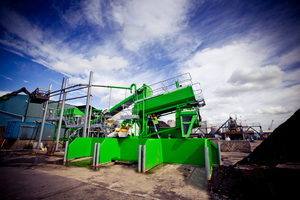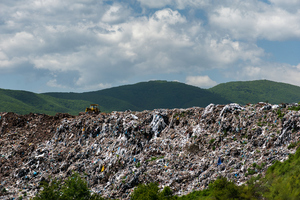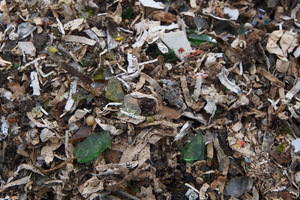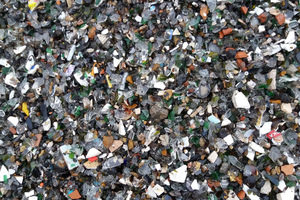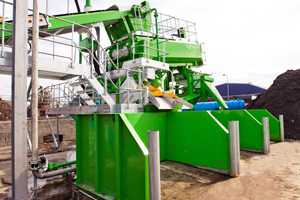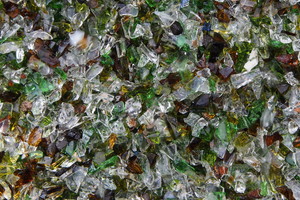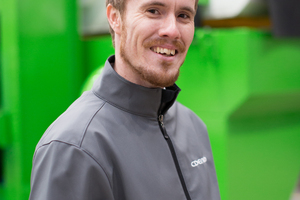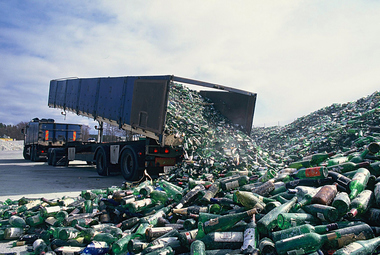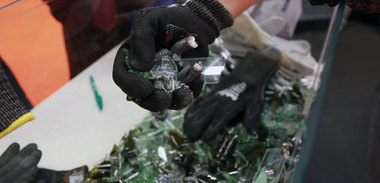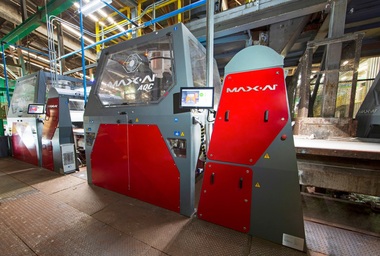Glass – production, application and recycling
Glass has been an important resource for many thousands of years, but today its uses have never been so varied and important to our everyday lives. Whether it is used as a drinking vessel, a window on the world, in fibre optics and smart phones, or in pharmaceutical, health and science applications, it really is hard to imagine going even an hour without some interaction with a glass product.
As well as the more obvious uses, glass has many other applications, advantages and a lot of potential. Glass is already used in several ways in new technology, from electrical insulation, to passivate components or as a hermetic seal. In future, with further development, we could see ‘smart’ glass bottles and containers whose colour changes depending on the liquid temperature; photovoltaic sunroofs to provide electricity for hybrid and electric vehicles; mirrors that can assess the health of the person standing in front of them. These existing and potential uses will see the demand for glass rise exponentially, and manufacturers and suppliers need to be ready for that.
Glass manufacture
The traditional glass production process very much follows the linear model of extracting resources, manufacturing a product, using it and then seeing it disposed of. This is a resource and energy intensive way of creating a product and does not make the most of the value available within the material. There have been positive developments though, with Glass Alliance Europe – the European Alliance of Glass Industries – reporting that over the past few decades, the energy intensity of glass manufacturing has reduced by 77 % and CO2 emissions by 50 % even with an increase in production. This is reportedly thanks to process innovation and the systematic use of the best available techniques.
However, a linear approach means used ‘waste’ glass is sent to landfill with a resultant environmental and economic cost. The cost of disposal for ‘waste’ has been rising for years thanks to landfill directives and landfill tax rises. As glass is made from ash, soda, limestone and sand, it can be recycled an infinite amount of times. Alongside the reduction in landfill, less energy is needed to melt and reform recycled glass than to melt down raw materials and start from scratch. It is said that one recycled glass bottle saves enough energy to power a computer for around 25 minutes Using recycled glass also means fewer raw materials need to be quarried, saving our precious resources and countryside. When it is recycled with maximum efficiency, each tonne of recycled glass saves more than its weight in raw materials, significantly reduces energy costs and vastly cuts greenhouse gas emissions, including CO2, nitrogen oxide and sulfur oxides. This message is well understood by the European glass industry – the EU is the largest glass producer in the world and has around one-third of the total global market share. Glass Alliance Europe facilitates the ‘Exchange of best practices and experiences on recycling [which] are… key for glass industries to increase even further the recycling rates of our products’. Currently an average of 50 % to 80 % of glass bottles are recycled, but there is still some way to go to reach the true potential of all glass recycling.
A more circular approach
The ‘circular economy’ approach looks to keep resources in use for as long as possible, extracting the maximum value from them while they are being used, then recovering and regenerating products and materials at the end of each service life. This saves virgin materials from extraction and maximises the value of resources already in use, often meaning rather than being a cost burden ‘waste’ can instead be an asset. New technologies can play their part in this approach by more efficiently diverting an increased volume of glass from landfill, preserving our precious resources and the environment. However, the efficient sorting of glass requires the recyclable material to be clean and this has not always been possible in the past. Any impurities reduce the value of the crushed glass and make it harder to sell, meaning even glass sent for recycling can end up being wasted. That is why new innovative technology not only focuses on sorting and classifying the glass, but also on removing any contaminants, including paper, organics (like labels and cork from wine bottles) metals and plastics. Along with the physical cleanliness, water treatment systems ensure the chemical cleanliness of products allowing them to be reused for a variety of purposes.
Up to the task
Conventional dry-processing techniques have limited output opportunities. Higher quality processing techniques now exist which safeguard resources and ensure vast outlet opportunities for glass to be reused, due to a higher quality end product. The new technologies can control output quality irrespective of input quality, which ensures subsequent glass manufacturing processes are much more efficient. New systems can combine a number of processes to ensure the glass is properly treated and the best end product is produced for recycling. They use a series of techniques including density separation processes, sizing, screening, attrition and high-pressure washing. Through these techniques lightweight and fine constituents are removed and where appropriate made available for recycling. High quality, clean, processed cullet – recycled broken or waste glass used in glassmaking – is then ready to begin its life again. The most effective new systems efficiently move the loaded material from one stage of the process to the next with minimal wear and tear, providing a reliable service and minimising any downtime. Using these effective processes to provide a high quality output reduces the life-cycle costs of glass recycling which, in turn, ensures products produced using these innovative technologies can realise yields that traditional technologies cannot.
New from old
Waste glass can be re-used endlessly in industries like the food and beverage packaging industry to create new glass containers. It can also be used as an additive in clay, where glass lowers the processing temperature and therefore the costs for producing tiles and bricks. In addition, the glass chemically bonds with the clay and makes the product stronger. An additional use is for recycled glass to be added to plastic where the finely ground glass readily replaces the calcium carbonate filler normally used. Even glass that is not reused for new products has it applications. For example, when manufactured to a uniform, sharp-free specification recycled glass, aggregate can be used in wastewaterfiltration systems in place of very porous, fine aggregate, such as sand. The recycled glass aggregate acts as a filter bed where the plant roots and natural microbial processes turn wastewater solids into treated water and benign solids. The new glass cleaning and sorting systems can be available with several modular options, meaning they can be used on a variety of sites, or they can be fixed turnkey installations for longer-term projects. This gives the user the flexibility required whatever their source of glass and market for the recycled product.
Getting consumers on side
The glass manufacturing industry is increasingly engaged in recycling, and the technology is now available to maximise resource use. The final part of the jigsaw is to get consumers – both private individuals and businesses – understanding the potential for glass recycling and committed to playing their part in ensuring glass products aren’t simply disposed of in landfill. This will be easier for straightforward glass products like bottles and jars, which are straightforward and commonly recycled, but needs to extend to other products with glass components too. Communication campaigns and initiatives have been demonstrated to make life easier for consumers, and help to increase levels of recycling. Keeping things simple and explaining the benefits are the best way to get people engaged.
HYDRO:GRADE glass system
CDEnviro’s HYDRO:GRADE material recovery screen can be used for a variety of materials to reduce waste and produce high-quality products for reuse. The system encompasses a series of techniques, including a two-stage density separation process, attrition and high-pressure washing. This means it offers extremely good levels of separation and removal of lightweight and fine constituents, ensuring the highest quality products are recovered. It was recently tested on site and the results were impressive offering a more efficient and costeffective way to screen and scrub glass. Along with the high performance standards, the contractor recognised there would be a significantly lower cost of ownership due to the excellent performance and robust specification of the industry-leading components. The recovery system has helped to improve the company’s working environment with lower noise levels than other glass cleaning solutions. Its power requirements and emissions are also reduced thanks to the use of mains electric power rather than a diesel generator. In addition the contractor combined the HYDRO:GRADE with a water treatment system to ensure the physical and chemical cleanliness of products for reuse without additional chemicals or air. The system uses recycled water, ensuring maximum water retention.
Efficient and effective
The solution minimises power requirements and water specifications to produce high quality products as efficiently as possible. Key efficiency features are:
The highly efficient separation process which ensures that all products are of the highest quality by minimising the level of unwanted constituents.
The integrated return pipework between the oversize sump and sump minimises installation time and ensures the most efficient transfer of material.
The option to grade and discharge two or three washed products.
Shaft synchronisation through single drive design. This ensures maximum attrition and efficiency.
Spiral designed paddles that ensure efficient transfer of power which results in highly efficient scrubbing of material.
Integration of all HYDRO:GRADE elements on a single compact, transportable chassis allowing for the unit to be moved to alternative sites quickly and efficiently.
Built to last
The highest quality components and intelligent design ensure a system that is built to last. Key design features, designed to guarantee maximum system uptime and longevity, include:
rubber lining
long radius bends
remote greasing
metals removal
easy maintenance access
Polyurethane mats on the dewatering screen guarantee maximum protection from wear
Material is efficiently moved from one stage of processing to the next using CDEnviro’s transfer point technology (TPT).
Author:
Andrew Wilson, Business Development Manager for Switzerland/für die Schweiz, CDEnviro

